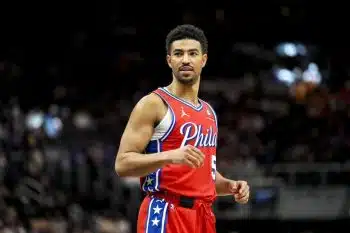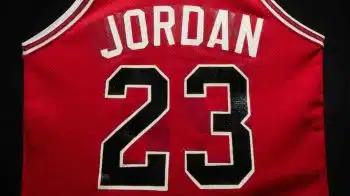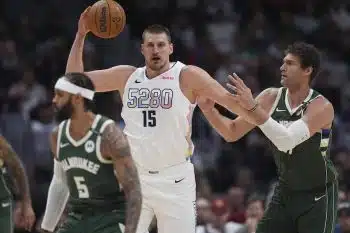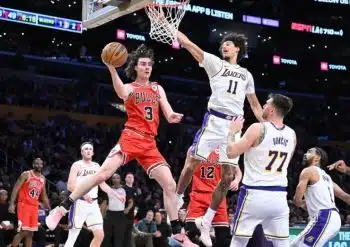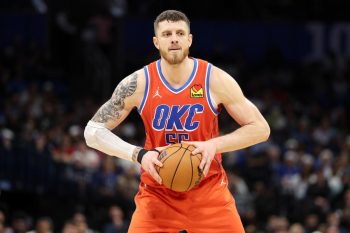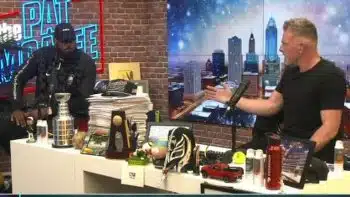NBA
NBA AM: Turning Point For The Nuggets?
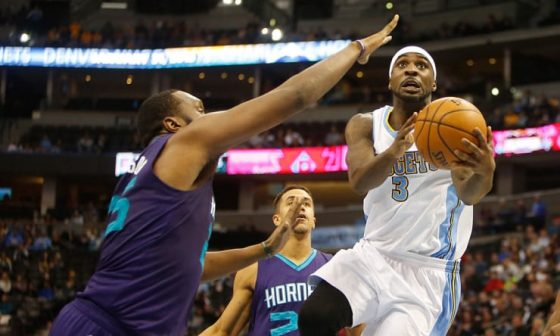
Is It Time To Blow Up The Nuggets?: The Denver Nuggets will face a tumultuous offseason. Not only do they need to find a head coach for the future, they have to mend rifts within their own locker room. After several seasons of ups and downs, confidence in the direction of the organization is waning among the team’s two cornerstone players – point guard Ty Lawson and forward Kenneth Faried.
For much of last season, both players pushed back on former head coach Brian Shaw regarding the direction he wanted to take the team. Shaw ultimately lost the confidence of his locker room and his front office and was replaced midseason by interim head coach Melvin Hunt.
As the Nuggets explore which coach should lead the team into the future, they are also weighing the notion of blowing up the team and starting over with a group that may buy into what the Nuggets are trying to build in a better way.
As good of a piece as Lawson is to build around, his lack of confidence in the direction of the organization has become somewhat problematic. Lawson represents the Nuggets’ best trade asset and it seems both parties are at least open to exploring Lawson’s trade value. For the Nuggets to truly turn the corner, a major trade may be inevitable and Lawson is likely the center piece of the deal.
In the case of Faried, the Nuggets have seemed somewhat apprehensive about Faried long-term, but they signed him to a multi-year contract extension last summer. Sources say this was more about locking in the asset and hoping the relationship would turn around. Faried, much like Lawson, wasn’t happy with the direction of the franchise but took the money anyway.
There are currently two schools of thought. One is the Nuggets hire an experienced head coach who can point the franchise in the right direction and maybe walk the players back from the ledge. The other is to blow the team up and build a foundation around players that want to be in Denver.
Nuggets president Josh Kroenke has said a few times that this offseason was about making sure the players on the roster want to be in Denver, and that’s a big part of their offseason plan.
Sources close to the process say Lawson and Faried have kept no secret of their discontent and unless the Nuggets can pull off something major on the coaching front or make a significant trade, both have indicated they’d rather see a trade instead of sticking around for a long rebuild.
When Lawson is at the top of his game, he is among the best point guards in the NBA. Faried, at times, has shown glimpses of being a star-caliber frontcourt player. Both could be very attractive trade chips if Denver decides to pull the trigger.
Sources close to the process say Denver has had no shortage of inquiring calls, but the Nuggets have not indicated one way or the other if they’re ready to pull the trigger. The Dallas Mavericks and Sacramento Kings are both said be high on Lawson.
The Nuggets are deep into their coaching search as well as starting their draft process. They are said to be weighing a number of options, some of which could include existing roster players including Lawson, Faried and possibly swingman Wilson Chandler. Denver’s final decision is far from clear; however, it does seem they have options if they genuinely do want to blow up the team.
A blowup scenario could bode well for Melvin Hunt as the organization really likes Melvin and sees him as a viable option to skipper a rebuild if the Nuggets opt to tear things down and start anew.
The challenge with trading a player of Lawson’s stature is getting real value and return; the Nuggets clearly would want draft picks and young players to justify moving a borderline All-Star.
As for Faried, his contract extension makes a trade before July problematic. If he was going to be moved, it likely happens once the new NBA calendar gets locked in, in July. It is possible that the Nuggets could agree verbally to something around the draft involving Faried that gets finalized in July.
The Nuggets do have a number of questions to answer, the biggest might be is this roster worth keeping intact and are these players committed to the direction the organization wants to go?
The answer there might help answer some of the other questions the team is trying to solve at head coach and in the draft.
Who Is Worth Max?: A common question asked in the offseason is what is this player worth? This year more than almost any, that question is probably going to be max, not because there are so many max players available, simply because max is going to mean something totally different in the coming years after the new NBA TV rights deal kicks in.
It’s easy to get caught up in the exact dollar amount a player is paid, but from inside teams more time than not a player’s salary is looked at as a percentage of the salary cap. A max for a player with less than seven years of experience is 25 percent of the salary cap. Today that number looks like $16.75 million next year. That number is going to look very different when the salary cap swells to just under $90 million next year when the same player’s experience will be worth north of $21.5 million.
The same math can be applied to smaller deals as well. A player that gets, say, $8 million against a $67 million cap this summer, equates to 11.9 percent of the cap. In 2016, 11.9 percent of the cap works out to $10.35 million.
A prevailing thought among NBA agents is that more teams will be willing to lock in players at what may seem like a large number this year, if only to avoid having to deal with what the percentage would equal in the new TV deal.
Locking a middle- to upper-tier free agent at max money now could be a significant saving, rather than approaching free agency in a year or two when a middle- to upper-tier free agent could cost as much as $20 million per season. While it may seem foolish to throw around max money to non-max players, max money will look very different inside the next two years as the cap balloons.
There seems to be a consensus among agents that locking in a middle- to upper-tier free agent in the $17 to $18 million range now is the best move for their clients. While some would say the doing a shorter-term deal and testing your value in the new NBA economy might yield more money, many believe locking in security at this rate is the best move.
Two huge factor for going to play a role in valuation this summer, one is that as many as 14 teams could have $15 million or more in cap space to spend this summer. The other is next year when the cap balloons so does the luxury tax line.
The fear most NBA teams have of the luxury tax comes off the table for the majority of teams, which could set up an environment for a number of players to be overpaid this summer. There is little doubt that some players are going to get massively overpaid in July, however when the cap swells in 2016 and more importantly 2017, some of those numbers are going to seem like a bargain, especially if those players involved can play to the top side of their ability.
Always About Potential: With the NBA draft less than 30 days away, NBA teams and players have embarked upon rigorous workout schedules in order to try to filter through who will land where.
In what’s become an annual ritual, would-be draft prospects go through a roller coaster of a valuation. In April and May, the storyline is all about potential, what a player could be. When the calendar flips to June, the storyline shifts to all the things a player can’t do. Some of this is real as teams get a closer look at would-be prospects, some of it is a little artificial as media and teams try to understand what a player really will be in the NBA, and misdirection comes into the picture.
The biggest misconception in gauging draft stock, especially from fans and media, is the notion that those players likely to be drafted at the top of the draft board are a finished product. In most cases, these players are 19 and 20 years old and are just scratching the surface of their ability. The more proven players with less untapped potential tend to slide down the draft board in favor of players who could have a much larger upside. That is simply the nature of the NBA draft.
For months starting in April, the narrative is always about how amazing a player will be in the NBA; however, by the time the draft rolls around at the end of June, most of those players are torn down in one way or another.
It’s easy to get caught up in the hype of what a player can’t do, but if history has taught us anything it’s that players with super high ceilings tend to do well in the NBA in the long-run, where players who have very obvious flaws or limitations tend to have middle-of-the-road careers.
While many would love to see the NBA draft be about players who can play right away, more times than not it’s about investing in a stock that could go through the roof inside the first three years. Most teams, especially those at the top, value that high ceiling and potential big reward as more important than ready to play right away guys.
It’s almost June, so expect to hear a lot more about what a player did wrong, can’t do or didn’t show, because that’s the nature of the draft process in June. Reality sets in a little more harshly than the dreams of April and May.
More Twitter: Make sure you are following all of our guys on Twitter to ensure you are getting the very latest from our team: @stevekylerNBA, @AlexKennedyNBA, @LangGreene, @EricPincus, @joelbrigham, @SusanBible @TommyBeer, @JabariDavisNBA , @MokeHamilton , @JCameratoNBA, @iamdpick, @jblancartenba and @CodyTaylorNBA .
